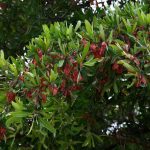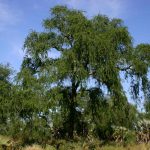TREE LIFE 131
JANUARY 1991
TRIBUTE TO DICK HICKS
It is indeed with a sense of deep sadness and loss that we record the sudden death of our Chairman, Dick Hicks, who had an unexpected heart attack on the 12th December, three days after our successful December outing. This is not just a blow to us individually, but to the whole Tree Society. The Society had become such a great part of Dick’s life that the two were almost synonymous, Dick and Maureen have practically been running the Society for the past three years. This arose because of Dick’s great enthusiasm for the bush while he traveled around Zimbabwe as Deputy Sheriff and Messenger of the Court he discovered spots none of us knew. So between slapping court orders on people’s possessions he would ask for permission to look at the trees on their property. It may sound strange, but Dick’s greatest contributions to the Society was his initial inexperience. When Dick took the chair he had been a member for just over a year and sat in what appeared to be the daunting shadow of experienced committee members. Yet it was precisely this fact that made Dick such an excellent candidate. Our society is varied, it learns from experienced members but we also have many new members. Just like adults soon forget the difficulties of those teenage years, experienced people forget the problems they too once had. Dick used his position near the bottom of the learning curve to re-examine both the bush and the Society’s teaching. He stimulated enthusiasm for the miombo wood-land around Harare, forcing us to look once again at those common species that we tend to cast aside. He initiated and organized the Ten Trees’ concept on an outing. This allowed beginners to recognize their limitations and stopped them from being swamped by lots of names. It led me to recall the days when I followed behind my mentors in the Society: Lola Irvine, Gill Masterson, Dick Petheram or Meg and Paul Coates Palgrave. After a few hours, arborial indigestion would strike and I would turn into zombie mode, letting the long names wash over my head.
Plants that baffle the inexperienced (like the eternally variable Flacourtia indica ) were conquered and with this growth came the desire to discover and explore new areas. They arranged longer trips to Hippo Pools on the lower Mazowe, Matepatepa, Shamva, the Great Dyke, Raffingora, Dichwe Lemon Forest, Kariba, Victoria Falls, Bulawayo and the Matopos, Tuli Circle, Fort Rixon, Masvingo, Beatrice, the Vumba and Mount Selinda.
Day trips for the Society were often weekend trips for them as they spent Saturday with our hosts, revelling in the bush. Dick and Maureen would pop up all over the country side, they bumped into us while we were swimming above the water fall on the alpha trail. Their interest in trees expanded to include flowers and pressed plants were accompanied with photographs. The photographs soon included distinctive barks as well as fruits and whole trees.
Dick did not let his health hamper his botanising. He must have had TB sometime during the Second World war while he was a Green Jacket in the Gurkha Regiment in Asia. This had gone undetected until the early 1980’s when the scar tissue flared up and he had half a lung removed. As a result Dick developed a heavy panting gasp that became an integral sound in the bush, particularly on hill climbs. Dick was a forceful person but often quiet, if pressed he would relate many humorous anecdotes about his life and the war, usually punctuated with a gleam in his eye and interspersed with a dry sense of humor and distinctive laugh. The Society has been greatly enriched by Dick’s valuable contribution. Our deepest sympathy extends to his sons Michael, Richard, Ian and Christopher, but most especially to Maureen: for you the bush will always carry memories of what has been a warm and very close relationship, one that few achieve in a lifetime.
Kim Damstra.
MASHONALAND CALENDAR
Tuesday 1st January 1991: Happy New Year
Tuesday 8th January: Because New Years Day falls when it does this year, our date with Tom Muller in his Botanic Garden will be a week later on 8th. Park your car at the Herbarium where we will meet Tom at 4.45 for 5 p.m.
Sunday 20th January: Visit to the Goromonzi area to meet Mr. and Mrs. Marr-Levin.
26th January: walk with Mark on the Falcon Golf Club Course in Hatfield.
MATABELELAND CALENDAR
On Tuesday, January 1st we have our New Year Party at the Blakes. From 1100 hours. First there will be a Tree walk, as the trees are waking up and the river has run.
On Friday 18th January weekend there is an excursion to the Gwaai river – details already arranged.
Sunday February 3rd : We go to Whitestones School, Burnside, too meet with some of the pupils. Meet there at 0830 hours, bringing tea and chairs. This will be morning only.
Sunday March 3rd March: We will go to Mr. Roy Stevens’ Shumba Shave Mkulu – a fabulous area. We are promised new walks. Bring a really portable lunch as it will be a long hike for those able. This will be all day. Meet at Retreat at 0830 a.m. It will be about 50km from there.
MATABELELAND NOTES
On Sunday 2nd December we went to Sunrising with the kind consent of Mr. Graham Paxton, for whose hospitality we are most grateful. In all we identified some 45 Indigenous Tree species. Apparently the water table has dropped 100 feet in the last nine years. So things were drier than in the past. There were three Acacias, A. fleckii, A. karroo, A. rehmanniana, Albizia antunesiana,
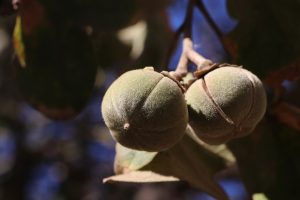
Azanza garckeana. Photo: Mark Hyde. Source: Flora of Zimbabwe.
Azanza garckeana, Bauhinia galpinii, Burkea africana, Carissa edulis, Clerodendron glabrum, Combretum hereroense, C. molle, Commiphora mollis, C. schimperi, Diospyros lycioides, Dodona angustifolia, Erythrina latissima, Ficus cordata, F. ingens, Flacourtia indica, Grewia flavescens, Kirkia acuminata, Lannea discolor, Maytenus heterophylla, M. senegalensis, Ozoroa insignis subsp. reticulata, Pseudolachnostylis, Rhus pyroides, Securidaca longipendenculata, Terminalia sericea, T. trichopoda, Vitex payos, Ximenia caffra, fruiting well.
-Chris Sykes
A SAFARI WITH A PACMYDERMATOUS DIFFERENCE
I apologise to Nick and Fundy for not attending the November outing to Sitra Potteries. Particularly as I had arranged for all of us to descend on their cottage.
Let me explain what I was doing instead :
Imagine opening your eyes to a vast green sea dotted with an endless archipelago of islands. Some islands are long and stretch across the horizon, others are so small you can see behind them from from your vantage point three metres above the water that gently splashes beneath you. As each island slides past a new field of view opens up and more islands are revealed. The islands are not rocky but each is densely vegetated with two species of palm. There are thickets of the wild data palm, Phoenix reclinata, which has fatter-shaped leaves and flexible trunks that recline over the edges of the islands. Every now and then the green crown is interrupted by a flash of the orange spathe which encloses the new flowers. It is too early to find the nature’s fruit, the kids who live in our road back home supplement their diet with these dates. Towering above the Phoenix are the tall stately trunks of the Ilala palm,
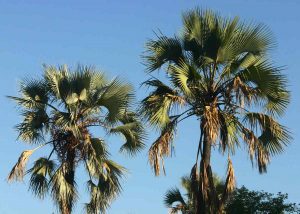
Hyphaene petersiana. Photo: Bart Wursten. Source: Flora of Zimbabwe.
Hyphaene petersiana. Their crowns consist of grey fan-shaped leaves with the flowering branches that are just starting to grow out in yellow and deep purple. Palm swifts loop into the dead leaves and every now and then a group of Meyer’s parrots let out alarmed shrieks as they dash off to the shelter of another island.
Its an idyllically sugary setting, heightened by the gentle creaking of the wooden saddle and the constant encouragement provided by the elephant-driver sitting astride the neck in front of you. Here in the Okavanga the terms howdah and mahout in particular, seem grossly inappropriate to African elephants. Botswana can be stinking hot but the rains broke last night. Although the sky is bright it is still partly overcast so my bare feet are well tucked behind Bennie’s warm ears. Elephants have no sweat glands but they do loose heat directly through the skin that covers the ears. Bennie was born in the Kruger National Park and is the largest of the three adults in this family and as he walks his spine moves across from one side of your buttocks to the other. In contrast Kathy, who comes from Uganda, has a remarkable flat back and her spine hardly sways at all. This morning Luuk and his wife Patsy are ensconced on Kathy.
Riding elephants lets you see things you would not notice. The elephant love palm leaves but they are particular about which leaves they choose. The green leaves of Phoenix are eaten, but only the dried leaves of Hyphaene were selected. Abu has a magnificent pair of tusks, he grips a leaf with his trunk then uses a tusk to yank the leaf from the stem. Benny had an unfortunate youth and has no tusks, he does not pull at a leaf with his trunk but grips it between his teeth, braces his neck and walks away till the leaf breaks off the stem.
Water berry trees – Syzygium cordatum grow along the edge of some islands. They are in full white flower and resemble the flowering gums to which they are related. Leading elephant past these trees is like walking a kid past the sweet counter. Waterberries mean snack time, not only For Abu, Kathy and Benny, but also for the seven juvenile elephant that complete our little herd. The youngsters glean from branches broken off by the adults. These stops allow us time to examine other trees on the island, including the odd marula (Sclerocarya birrea), a thicket or two of Ziziphus mucronata and the diamond-shaped leaves of Euclea divinorum.
The lush green grasslands team with game. It is strange sitting at eye-level with giraffe and towering over the many zebra, wildebeest and buffalo. The impala and tsessebe will begin calving now that the rains are here and before the end of the week many youngsters will be running alongside their mothers. We have just been trying to creep up on the red lechwe that feed in the shallow water of the swamp but they maintain their distance. Yesterday we saw a pair of lion, watched a hyaena lazing in a water-hole and had a magnificent sighting of four cheetah. From this height the view extends across the plains so we can spot the odd steenbok bouncing off, or peer into the swamp grass and see reedbuck crouching silently. As we move through the swamp the little reed frogs (Hygrolius marmoratus) leap out from in front of the elephant’s feet. At night the warm air is filled with their metallic call.
Blacksmith plovers dart around the shorter grasslands as we make our way towards the mainland, a long tongue of Kalahari Sand that extends well into the swamp. Amongst the grass are the short stems of one of the shortest Figs, Ficus pygmaea. It belongs in the same sub—genus as the cultivated Fig (F. carica), together with F. capreifolia and F. exasparata. Species in this group are dioecious (with male and female plants) and often smell like the cultivated fig. This is the first time I have ever seen it, although it does grow somewhere in the North west of Zimbabwe. The edge of the grassland is interspersed with young Acacia karroo that have been damaged either by the seasonal flooding or the subsequent fires. Whatever the case they are coppicing from their bases. Nearby are well-developed bushes of
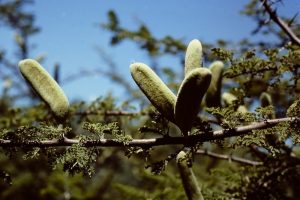
Acacia hebeclada. Photo: M. Bingham. Source: Flora of Zimbabwe
Acacia hebeclada, easily identified by the pods that point straight upwards, resembling the candles on a Christmas tree. Just at the moment it is hard to see the top of any tree that is not ornamented with the distinct silhouette of a Grey Lourie. As the elephant approach they fly off, shrieking out their coarse ‘go—way’ cry.
Abu and Kathy have disappeared into the narrow fringe forest ahead. High in a Leadwood tree (Combretum imberbe) a Fish Eagle is being mobbed by a merciless pair of Lilac breasted Rollers. Benny follows the other elephant and we enter the dense shade cast by tall ebonies Diospyros mespiliformis and pale barked fig trees Ficus sycomorus. Large liver coloured flowers hang on long stalks from the stately sausage-trees Kigelia africana. The forest echoes with the mournful duet of the swamp Boubou which sounds like a gently swinging gate with rusty hinges, answered by a clicking reply.
Beyond the shade we pass into an open stand of the silver-leafed Terminalia sericea. These trees look like pagodas with successive tiers of horizontal branches. Each tier consists of a mat of tight rosettes of leaves, the spaces between tiers allow light to penetrate to the layer below. The branches are covered with the pale spikes of flowers that exude “a sickly sweet scent”. Some compare the smell to old socks but it does have a distinct sweetness. Amongst the Terminalia are other trees, also about 5m high with soft furry leaves that hang downwards. The tree looks like an elongated Combretum molle, but its leaves are alternate. Ah, Benny has moved close enough for me to collect a sample, this sure beats jumping or using a throwing string! The simple leaves each have two stipels on their stalks, these are characteristic of the genus Lonchocarpus, so this must be L. nelsii, which I have only seen before in the Botanic Gardens, Harare. The other species, L. capassa (rain tree) grows in the fringe forest.
A bright yellow Peltophorum africanum slides past before the vegetation changes once again and we are surrounded by the dark sinuous trunks of mopane (Colophospermum mopane). Around and above us the branches are bare except for the odd resinous gleam of emerging leaves. Beneath us the pale soil is caked on the flat ground which is interspersed with dried-up pans. Between the trees the earth is bare of vegetation but littered with swirls of the rich red-brown mopane leaves. A herd of male impala wander out of the mopane woodland towards two baobabs (Adansonia digitata) that hang with hundreds of large white flowers.
We have slowed down again as the drivers maneuvre around the denser vegetation of the forest fringe. Suddenly there is a loud trumpet and Patsy and Luuk come jogging past looking some what startled! One of the youngsters had gotten underneath Kathy’s feet. I was reminded of my mother’s reaction when, as a toddler, I gripped onto the heavy cotton of her Flared skirt patterned in bold red and black designs of the late 50’s. Kathy is told to ‘tail up’ and is pacified the moment she links her trunk to Benny’s tail. We proceed once again with Kathy lumbering along behind like a chastised child. Her face an arm’s length from Benny’s rear end but she seems unperturbed by the bubbles and gurgles that emerge at regular intervals.
We are out on the open grassland again and heading for open water surrounded by tall Wattled Cranes and a pair of Saddle billed Storks. Abu enjoys wading and strides in. He is followed by little Gika who always loiters near Abu, grooming him as a devoted attendant. Gika is easily distinguished from the other youngsters as the edges of his ears are folded over. Kathy follows Abu but remains in the shallows, Abu is now so deep that only Gika’s trunk remains as a periscope above the water. Benny dislikes water and skirts around to meet up with the others on the far side. Gika emerges wet with mud and Abu has a distinct tide line across his middle.
It is time for brunch so we amble back to the luxury of Matsaudi Camp, nestled in the shade of sausage-trees and rain-trees. This sure is a safari with a difference, of which Randall should be proud.
Kim Damstra.
CHIRINDA FOREST By B. Goldsmith (Forestry Commission)
Birds
Doctors Saunders, senior and junior, would occasionally visit Chirinda. Their wealth of knowledge on bird life always made interesting conversation.
Crowned Eagles can be seen often as small specks in the sky ready to pounce on an unwary Samango monkey or Forest guinea fowl. A powerful bird with talons which lock on siezing its prey.
Forest or Crested Guinea fowl are small but prettier than the tree veld species. When disturbed their flight is almost vertical which shows good adaptation to a tree environment. When viewed in forest margin thicket whilst feeding, they behave much like domestic fowls. Here one can see the sheen on their deep grey-blue bodies. The white nape and curly feathered head crest are conspicuous. They do not like to venture into open country.
The Buff Spotted Flufftail is a small bird with a mournful evening call, difficult to pinpoint. The Ndau believe this call is made by an enormous snake. The late M. T J Odendaal of Houtberg agreed with them. This bird is a skulker in dense thicket.
Green Loeries are common fruit eaters. Gorgeous green and crimson when in flight but perfectly camouflaged when still. A raucous voiced bird.
Narina trogon, an elusive red and green parrot-like bird more often heard than seen. Emerald Cuckoos are small birds with striking green chests and wings.
The clown of Chirinda is the black and white silvery cheeked hornbill. This big, gregarious, mainly fruit eating bird, congregates in large groups at feeding tine. They fly with an awkward up and down motion. It causes much wing and body noise through the air. Their honking calls can be heard throughout the forest. I have watched them eating avocado pears. They slip and slide off branches as though falling, but this does not perturb them in the least. They forage far afield wherever fruit is available. When termites swarm these intelligent creatures position themselves in nearby trees in the termite flight path. They simply open their beaks and close them when a good accumulation has built up. I think they pair for life. A male is easily distinguished from the female because of his larger casque which gives his upper beak a two tiered appearance.
Reptiles
The Chirinda Cricket Frog is a small dark brown creature which lays its eggs in rotting vegetation whence the tadpoles metamorphose within the egg capsule, away from water.
Arboreal /snakes like the Vine or Twig snake. Boomslang and Green Mamba are common but they avoid the lower shaded under storey. Dr. Broadley collected the first Forest Cobra recorded in Rhodesia at Chirinda. It is quite a large, fast moving, cheeky snake. It can be unnerving to see a very shiny, as though lacquered body, lying across a log in the sunlight. It appears to favour the shrubby under storey. This adaptable snake can catch fish by constricting them. It is quite at home near dams bordered by thick bush. I teased a foot long specimen which became quite aggressive when his escape was blocked.
Gaboon vipers have been found in Chirinda but they prefer drier, warmer forest patches and are common in the hot Busi river valley of Mozambique.
Rhamgholeon marshalli: this placid little chameleon is less than 6″ long. It feeds delicately off soft flies, catching them unerringly on the end of its sticky tongue. Once I kept one For Mr G.L. Guy, past curator of the Queen Victoria museum. By placing him in a leafy branch over a rotten mango I ensured that he was kept constantly in a good supply of fruit flies. I observed a male and female feeding off flies attracted to the profuse small white Flowers of the tree Tannodia swynnertonii. These were left undisturbed as I could not bear to see them captive. The male is smaller than the female. The jaw is like a blunt ended pair of long nose pliers with the bottom half shorter as though broken off. .
(To be continued : supplied by The Zimbabwe Rhodesia Science News Vol. 14, No. 3 – March 1980.
KIM DAMSTRA CHAIRMAN


